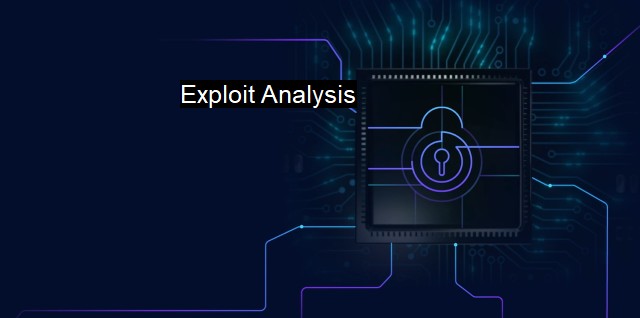What are Exploit Analysis?
The Vital Role of Exploit Analysis in Cybersecurity and Antivirus: Understanding Vulnerabilities and Defending Against Attackers
Exploit analysis is a critical component of cybersecurity and antivirus solutions. It refers to the systematic study of the tactics, techniques, and procedures used by cyber attackers to intrude into a system or network. Exploit analysis provides valuable, actionable insights into possible vulnerabilities that have been exploited, the consequence of the exploit, and the degree of harm an exploit could bring to the system.Let's begin with an understanding of what an exploit is. an exploit is a piece of software, a chunk of data, or a sequence of commands that takes advantage of a bug or vulnerability in order to cause unintended or unanticipated behavior to occur on computer software, hardware, or something electronic (usually computerized). This behavior, frequently undesirable, can range from data breaches, thus giving access controls to the hacker, and network intrusions, to shutting down systems and running unauthorized processes in the defected system. Guidelines for implementing adequate defense mechanisms can only be provided when one knows what threat they are confronting, and that is where exploit analysis comes in.
Exploit Analysis, therefore, is the process of picking apart an attack or the exploit code and understanding what the attack aims to achieve and the method involved therein. That way, it helps reveal the anatomy of the exploit. The ultimate goal of the exploit analysis is to figure out how cyber adversaries pose threats to information systems, suggest ways to defend against their illegal operations, and evaluate the potential damage they might instigate.
Exploit analysis has widespread uses in the cybersecurity field today. One significant use is in creating what is called 'signatures.' These are methodologies to detect previously unseen exploits or malware. Signature-based detection is a common method employed by antivirus software to detect malware. The uniqueness of the exploit or the patterns based on the 'signature' detected aids in identifying the malware or the intrusion the system might have suffered. One caveat with signature-based detection is that it can only discover previously recognized exploits.
Another form of exploit analysis can look at vulnerabilities, emphasizing the inspection of software code to identify any potential weak spots in coding structures that could be susceptible to exploiting. It is employed primarily in applications' alpha and beta versions to ensure any defects identified in this analysis plan can be fixed comprehively even before the software is released to the wider public. It helps prevent the exploitation of software and systems and the resulting cyber-attacks.
With the instrumentation of exploit analysis, organizations can mitigate the risk of future breaches. Exploit analysis provides comprehension on preventive measures that can be put in place to circumvent potential exploit attempts. This may involve changing system configurations, updating or patching software or even pursuing more substantial changes in system design to better counter the exploit attempts.
One key challenge that arises in exploit analysis is the everlasting complexity of the threat landscape in cybersecurity. Hackers aren't stagnant. They are continually learning and devising new methods to breach systems, launching unknown attack vectors that systems previously haven’t witnessed. This been said, each exploit analysis disassembled and understood reinforces cybersecurity by adding data about weaknesses that need to be addressed and divulging more about methods employed by cyber attackers.
Exploit analysis holds a pivotal part in cybersecurity and antivirus protection. The study of exploits, coupled with threat intelligence, unbosoms the intruder's methodology, spotlighting mitigations against future exploits, and underscores the importance of persistent exploration. Every new exploit deciphered gives rise to a more robust and more resilient defensive frame against cyber threats. This perpetual cycle of learning, understanding, and reinforcing ensure that organizations stay one step ahead of the malevolent cyber actors determined to infringe upon their security, thus keeping their information and network perimeter secure.

Exploit Analysis FAQs
What is exploit analysis?
Exploit analysis is a process of identifying and analyzing vulnerabilities in software or systems that can be exploited by cybercriminals. The analysis is done to understand the nature and severity of the vulnerability, and to develop countermeasures to prevent exploitation.Why is exploit analysis important in cybersecurity?
Exploit analysis is crucial in cybersecurity because it helps identify and fix vulnerabilities before they can be exploited by attackers. By analyzing and understanding how an exploit works, security experts can develop effective countermeasures to prevent attacks and protect systems from potential threats.What are the steps involved in exploit analysis?
The steps involved in exploit analysis include identifying the vulnerability, reproducing the exploit, analyzing the code, determining the impact of the exploit, and developing countermeasures to prevent exploitation. This process requires a thorough understanding of the software and system architecture, as well as knowledge of common attack techniques and tactics.What are some tools used in exploit analysis?
There are various tools used in exploit analysis, including debuggers, disassemblers, decompilers, network analyzers, and virtual machines. These tools help security experts analyze and understand how an exploit works, identify vulnerabilities in software and systems, and develop effective countermeasures to prevent exploitation.| | A | | | B | | | C | | | D | | | E | | | F | | | G | | | H | | | I | | | J | | | K | | | L | | | M | |
| | N | | | O | | | P | | | Q | | | R | | | S | | | T | | | U | | | V | | | W | | | X | | | Y | | | Z | |
| | 1 | | | 2 | | | 3 | | | 4 | | | 7 | | | 8 | | |||||||